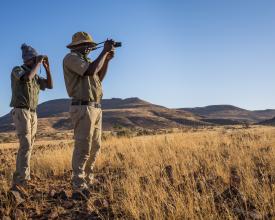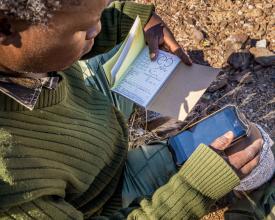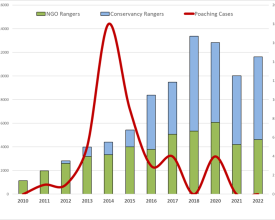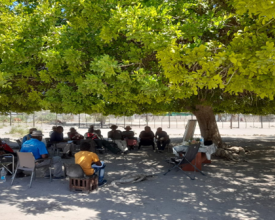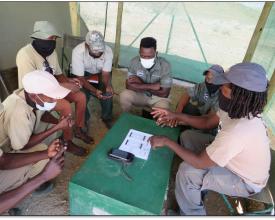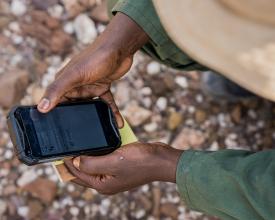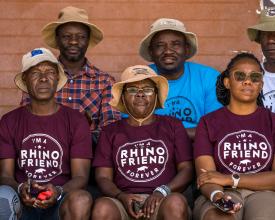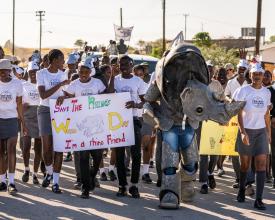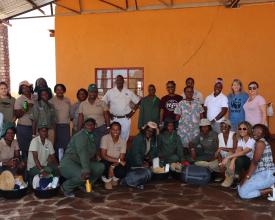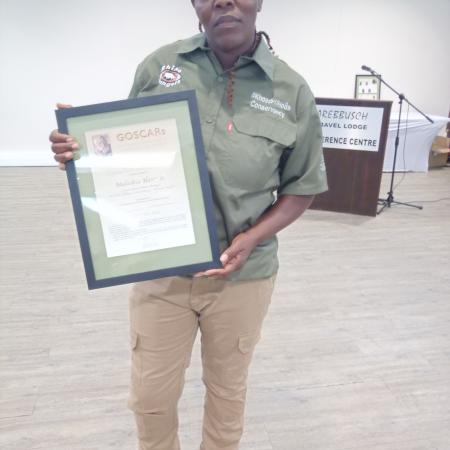
Harnessing local knowledge to protect the free roaming black rhinos in the Kunene and Erongo regions of Namibia - let locals fill the boots.
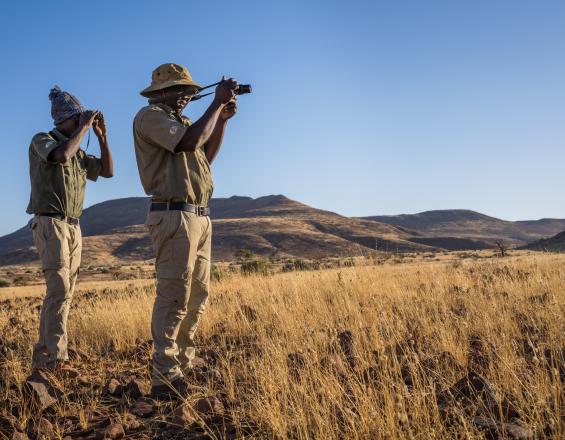
Our aim is to protect the World's Last Free Ranging Black Rhino population in the open access landscape of Kunene and Erongo regions in Namibia, taking a landscape-level approach by working alongside communal conservancies in the 25 000km2 area. For 40 years our trackers and conservancy rhino rangers have worked tirelessly in the rhino landscape to mitigate poaching, human-induced disturbance and threats to the species, contributing to the safeguarding of the black rhino population in the north-west. This population has been noted as a national asset to Namibia and is an income generating resource through rhino tourism and various employment opportunities created, contributing to livelihoods and income diversification, supporting the traditional livestock farming and agriculture. Communal conservancies in the Kunene and Erongo regions are recognised as rhino custodians allowing access to benefits for communities and expanding rangeland for rhinos.
Context
Challenges addressed
-
Poaching
-
Lack of capacity and innovative technology
-
Improper infrastructure
-
Inadequate supply of equipment
-
Drought
Location
Process
Summary of the process
Our proposed ‘building blocks’ complement each other as they harness different yet powerful fundamental values and are critical to be conducted through our projects. They may occur at the same time or in a sequence depending on the type of project. Species conservation especially in a communal landscape requires strong collaboration amongst the different role players and is only made possible through engagement. Communities play a big role as they set aside land for conservation through their zonation planning. By engaging the communities they are motivated and value the rhino more. In turn conservancy management can enter into joint venture agreements with tourism operators and improve the livelihoods of local people through job creation. Awareness raising and outreach is of utmost importance, we aim to engage youth through sports as they are most likely vulnerable to poaching syndicates.
Building Blocks
Engaging key stakeholders
Since inception in 1982 we have built strong relationships with local communities, conservation NGOs, Ministry of Environment, forestry & Tourism and Traditional leaders in the rhino landscape.
Our work benefits the local communities through the creation of job opportunities as trackers and rhino rangers. By creating a healthy environment for rhino population growth, we have enabled custodian conservancies to sign agreements with tourism partners, this creates job opportunities in the community and additional income for the conservancies as tourism is the highest income generating industry for the majority of these conservancies.
Enabling factors
-
Constituted communal conservancies, with clear standard operating procedures and constitutions.
-
Management agreements between tourism Joint Venture (JV) partners and custodianship agreements between the conservancies and the government.
-
Strong partnerships with other conservation NGO’s in the landscape
Lesson learned
-
Conservation is a success when all stakeholders are equally engaged
-
Local knowledge is essential and can be a good guidance in decision making
-
Engagement enables us to identify and agree on areas of need and improvement
Capacity building and innovative technology
Rangers are trained on the use of new SMART technology used to record patrol data. It is crucial to have well trained and equipped ranger teams to collect accurate data during their patrols.
Enabling factors
-
Availability of funds
-
Access to technology and training of staff in using the technology
Lesson learned
-
Individual rangers have different capacity building needs, we identified that there is a need to focus on individual rangers as well rather than just providing group training.
-
Peer-to-peer learning and training is useful
Research and Science based decision making.
Our team has identified the importance of accurate data collection, regular monitoring and oversight of data is done by the science and research adviser and Chief Operations officer to ensure accurate data is uploaded to the database. Population management and scientific decisions concerning the rhino population in the country are guided by the data collected during monitoring conducted by our patrol teams. Data based inputs are used to define the carrying capacity for wild-life based tourism and to plan and manage conservation and development activities.
Enabling factors
-
Availability of resources
-
Strong partnerships with like-minded conservation partners in the landscape
-
Supporting policies and frameworks
-
Memorundum of understanding with the local government
Lesson learned
-
Social and ecological monitoring enables a thorough understanding of the impacts of activities such as rhino trekking tourism on the rhino population.
-
Effectiveness of our efforts can only be assessed if long-term monitoring data is in place that provides temporal evidence of whether management goals and objectives are being fulfilled.
-
Science-based adaptive management is a very dynamic process which requires commitment from all stakeholders involved.
-
As monitoring is conducted by well trained conservancy rhino rangers (CRR) and Save the Rhino Trust (SRT) trackers, it increases their environmental awareness and provides a sense of ownership and motivation to protect the rhinos.
Awareness and community outreach
The purpose of this building block is to ensure that the broader communities are involved in the conservation efforts through activities that they are passionate about i.e youth through sports, school children through reading programmes. This helps to improve the connectedness that the local people have with the rhinos and they value the rhino more.
Enabling factors
-
Organized youth groups and structures
-
Willing and welcoming community
-
Strong partner co-operation
Lesson learned
Feedback meetings attended by conservancy leadership have proven to be an important communication tool to discuss objectives, challenges and ways to improve the monitoring programme. We have also implemented various projects to engage local communities through sports, reading programmes and youth clubs. Through awareness campaigns local people feel and realize the important role they play towards the conservation of rhinos.
Gender Equality/Mainstreaming
Female rangers play an important part in the conservation of black rhinos in the Kunene and Erongo regions of Namibia. They are equally willing and able to conduct patrols and are fully supported by the custodian conservancies.
Enabling factors
- Capacity building opportunities
- Knowledge exchange with partner conservancies
- Supportive management and employment policies
Lesson learned
We have learned that female rangers are willing and able to conduct patrols together with their male counterparts.
Impacts
-
Zero poaching of rhinos in our landscape, March 2023 marking 31 months without poaching.
-
13 Fly-camps upgraded, these are satelite sleep-out camps for rangers during their patrols in the landscape.
-
SMART technology adapted and used across the landscape
-
Expansion of the Conservancy Rhino Ranger programme to a new landscape, 20 participants trained in basic rhino monitoring
-
25 Save the Rhino Trust (SRT) trackers and 33 Conservancy Rhino Rangers (CRR) trained on the use of SMART devices. Save the Rhino Trust trackers are fulltime employees and salaried by Save the Rhino Trust, whereas Conservancy Rhino Rangers are employed and paid by the communal conservancies
Beneficiaries
-
Communal conservancies
-
Conservancy members
-
Joint venture tourism partners of the respective conservancies
-
Namibian population as a whole
-
Ministry of Environment, Forestry and Tourism
-
Save the Rhino Trust (SRT)
-
Travelers/ Tourists who value wild rhinos
Sustainable Development Goals
Story

The community game guard and/or ranger workforce in north-west Namibia is heavily male-dominated. Yet a few courageous women are beginning to change all that. While not the first female rhino ranger, Maleska Harases of ≠Khoadi-//Hȏas Conservancy, has been one of the most active and top female Conservancy rhino ranger performers presently rivaling many of the men. In 2022, she logged 114 Active Field Days, 21 confirmed Rhino Sightings, and 1161 Foot Kilometers which positions her ahead of many of the male rangers. In fact, her average foot kilometer per day rate – which enables comparison between rangers who often do not patrol at the same frequency due to different scheduling approaches – finished in the overall Top 20 at 14.5 kilometers per day surpassing over 80% of the other male rangers. She joined the programme in November 2020 and since has produced a total of 202 Active Field Days, 54 confirmed Rhino Sightings, and 2706 Foot Kilometers to protect what she refers to as ‘her rhinos’. Further noteworthy, is that despite ≠Khoadi-//Hȏas suffering a number of poaching incidences until 2017, not a single rhino has been poached on Maleska’s watch as a ranger! She is a role model for other women who think that a ranger’s work is only fit for a man. In her wake, 2 additional female rangers have since joined her at ≠Khoadi-//Hȏas and another 4 female rangers presently serve as Conservancy Rhino Rangers around the region. While her individual performance and statistics may not necessarily rank in the top 10 echelon, Maleska exemplifies the future of community-based rangers.
Due to her bravery and commitment Maleska recently won an award at the second Garth Owen Smith Ranger Award (GOSCARS) ceremony in Namibia for his exceptional performance in 2022. The awards have been set up to recognize outstanding community ranger work across Namibia in remembrance of the late Garth Owen Smith, widely recognized as a key founder of the Namibian community conservation programme in the early 1980’s.
